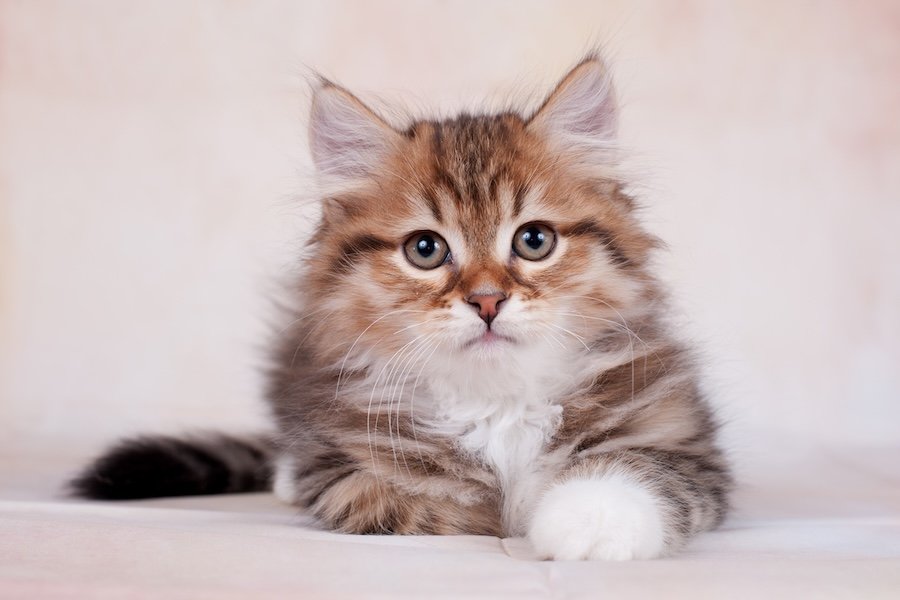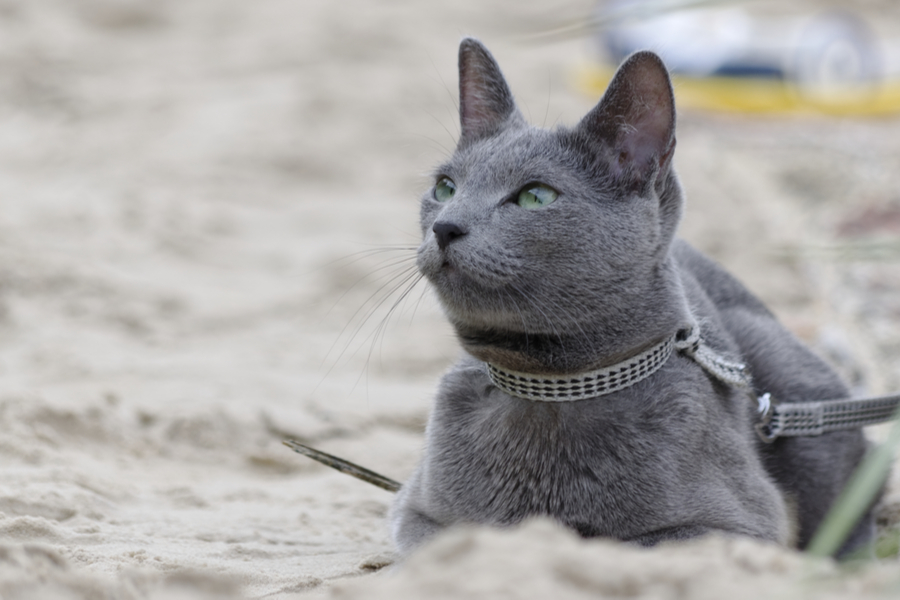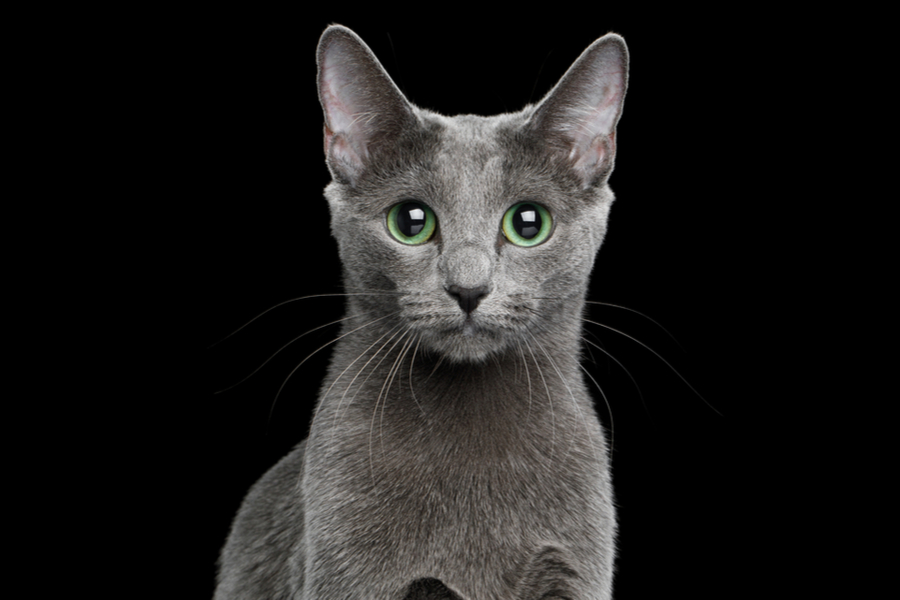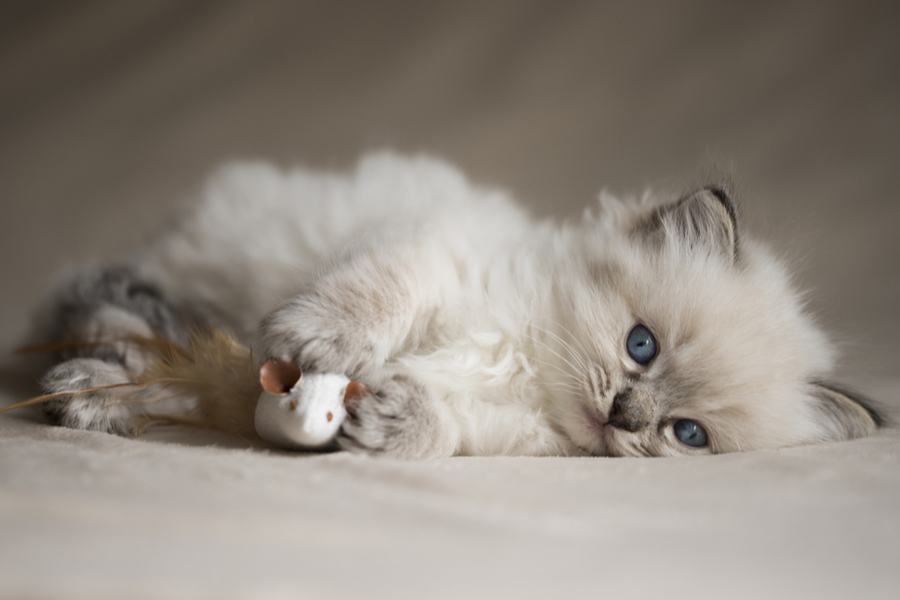Average sizes and life expectancy for this breed:
From Russia with love: that's definitely what the Siberian cat is all about. This native feline from Siberia's forested area and subarctic climate is a massive ball of love with a glamorous long, dense, and protective coat.
Siberians are an active yet highly affectionate cat breed. They are playful, happily chasing a feather toy and following their human companion wherever they go. Siberians make an excellent feline companion and love to cuddle on cold winter nights.
Although they adore attention, they are not needy and will wait good-naturedly to spend time with their family. Their calm and gentle nature makes them a great candidate for serving as a therapy cat. In addition, these intelligent cats are natural problem solvers.
Siberians have a long history, with the earliest known records dating back to the 1800s. A slow-maturing cat breed, the average Siberian reaches its full magnificence when they are about five years old.
Their semi-longhair coats change with the season. In winter, they have a dense, full triple coat that would have protected them from the harsh elements in native Russia. They shed their winter coat in summer for a shorter, less thick variant.
If you yearn for a warm cuddle companion for those cold nights, the Siberian is the ideal feline family member for you. These Siberian cats will follow you from room to room and will delightedly join in whatever you are doing. They are well-suited to any home with individuals who will love them and comb or brush their coat a few times a week.
See available kittens




The Siberian’s early history is brief. This is because there are no records of when the cat breed arrived in Siberia or where they came from. What we know is that they have been cited in fairy tales and children's stories for as far as 1,000 years ago.
In a popular folktale in Russia, a smart and mischievous cat was abandoned in the Siberian Forest by his annoyed owner. Though smaller than most animals, the cat was strong-minded not to become prey. With some humour and a little luck, the Siberian was able to partner with a fox. From there, he begins to scare a bear and wolf into believing that he is the new governor of the animals.
This story fits the cat's unique skill to survive in the unforgiving climate of Siberia. Famines and droughts were common during the first half of the 20th century in the area, which meant that cats like the Siberian had to fend for themselves. In fact, cat owners had almost no hand in their breeding. That's why their personalities and physical appearances developed together with their survival needs. Highly intelligent, tough, and waterproof, these were the only real requirements for the Siberian.
During the 1980s and 1990s, cat clubs and shows became more prevalent in major cities in Russia. When the Siberians were first shared with the rest of the world in 1990, they would instantaneously win international fame. And in 2006, they had achieved recognition from all of the major cat associations worldwide.
Today, Siberians are a popular breed for families with children and other pets. This cat has a delightful personality to match its outstanding appearance and an ideal lap cat for those who want to snuggle with their feline companion.


Siberian cats are a medium to large cat breed with an overall appearance of outstanding physical strength, power, balance, and alertness, and a sweet look on their faces. Their beautiful eyes vary in colour from green to gold and all colours in between. Some even have two different shades, and some have blue eyes.
Siberian cats are a natural breed and represent the climate where they developed with their very thick, medium to long, water-repellent triple coats. Their coat is accentuated with a ruff around their neck, fluffy britches, and a thick tail that is usually carried up to wrap around their faces and paws to keep warm.
Lynx tipping on their ear is permitted, and full ear furnishings are a must. This means that their ears' tops can have hair that makes their ears look pointed when they are actually rounded. The insides of their ears have hair to protect them from the elements.
Their glorious and useful fur comes in various colours and combinations, with or without white markings, and tends to stay fairly tangle-free, needing only sporadic brushing. Luckily, Siberian cats like to play in the water, so if you bathe them regularly as kittens, they may enjoy bath time.
Siberians are very loving and have playful characters. These cats mature very gradually, both physically and emotionally. It can take the Siberians as long as five years to reach adulthood. This means they devote a substantial portion of their lives to acting like kittens.
Despite their youthful demeanour, Siberians are characteristically mellow and quiet. When they make noise, it will be a little chirp or purr to express their affection to their human companions.
This cat breed is generally not aggressive, but their strong devotion tendencies can lead them to attack other animals they might see as threats. These cats enjoy adventure and challenges. They are also outstanding mousers who enjoy roaming around the premises for pesky rodents. When Siberians are not hunting and playing, these cuddly lap cats adore snuggling and spending quality time with their human companion.
Siberians use their unbelievable intelligence to solve all kinds of problems like discovering how to open the door to be with their human companion they adore, how to open the cupboard to get extra food, or how to retrieve their favourite toy their human companion thinks they have so smartly hidden.
Siberians are powerful, lithe cats that can jump great distances and heights and appear as though they are flying through the air. But despite their large size, they are skilful at negotiating hindrances in their path without knocking them over.
These intelligent Siberians love a challenge. With that, their living environment must offer them toys to play with and people to keep them active and entertained. When Siberians are not playing and being entertained, they are more than happy to snuggle with their favourite human companion and relax for a while.


As an active and large cat, cat owners have to put in extra work to train and exercise them. Without gentle training and active playtime, Siberians may start to misbehave and get themselves into all kinds of trouble.
Fortunately, this cat breed is super smart; thus, easy to train. Clicker training is a joy with this breed, especially as a form of encouraging reinforcement training. Make sure to teach them early and regularly so that they become used to obeying commands and get the opportunity for mental stimulation as they grow older.
Challenge their bright minds and keep them focused by teaching them commands, games and tricks. Give them many puzzle toys and other interactive toys that will reward them with kibbles or treats when they learn how to operate them.
Because of their natural confidence and curiosity, they are ideal for harness training. They love exploring the great outdoors, and the exercise is extremely beneficial for them. However, do note that wearing a harness may take a little bit of practice and time.
When you are not training them, make sure that your cat has access to toys and games. Some of them characteristically know how to play fetch, so always keep small felt toys around that they can simply retrieve. They also enjoy games that will prompt them to jump and show off their skills.
When a Siberian is properly socialised and trained during their kitten hood, they will thrive as a well-rounded and well-mannered feline companion.
The Siberian's thick triple coat must be brushed or combed several times a week to avoid mats or tangles. Their coat will shed in the spring and fall seasons; because of this, you may need to groom more often during these times. A bath is seldom required, which is a good thing because their coat is very water-resistant. It can be hard to get a Siberian wet enough to shampoo them.
Cats must get used to combs and brushes from an early age to avoid matted fur from the offset. There's a wide variety of cat combs and brushes on the market. You can start with a soft brush that does not pull at their fine kitten fur or damage their skin. Each time you finish brushing, give them a small treat. If regular coat care does not cause any issues, try more effective tools when they reach adult age.
Daily dental hygiene is best, but weekly brushing is considered sufficient enough to prevent them from getting periodontal disease. Trim their nails twice a month or when needed and wipe their eyes regularly to eliminate any discharge.
Check their ears weekly and if dirty, wipe them out with a cotton ball or soft damp cloth moistened with a vet-approved ear cleaner. If the ears have a foul odour, it is best to contact your vet for treatment.
Their litter boxes should always be clean as they are precise about bathroom hygiene. If it is left unclean, they may use other places in the house.


Siberians are generally a healthy cat breed. Their life expectancy is between ten to eighteen years with proper care, exercise and a high-quality diet. However, like many other cat breeds, they are prone to a few health conditions.
Because of these potential genetic conditions, it is essential to only get a Siberian from a registered breeder who runs DNA health checks on their cats and kittens. Seeing the results of this test will give you greater peace of mind that your new kitten will lead a long and healthy life.
Siberians are very friendly and social animals who want to be near their human companion. As they are fearless and laidback, they love the company of children, cat-friendly dogs, and other animals. However, Siberians don't like being left alone for long periods so they best suit a home where their companions are often around and willing to play.
They are a quiet cat breed that harmoniously expresses themselves through sweet mews, chirps, thrills, and lots of purring. They get along with almost everyone, including children and other animals.
It is always recommended to introduce pets gradually and in controlled environments to make sure they learn to get along well. Furthermore, always supervise younger kids to avoid accidents.


We can connect you with Breeders that are specialized in this particular breed.
See available kittens
Myanmar
Size : Medium
Coat : Long
Registration : GCCF, TICA, CFA, FIFe
Vocality : Low
Hypoallergenic : No
Grooming : Everyday

United States of America
Size : Large
Coat : Long
Registration : GCCF, TICA, CFA, FIFe
Vocality : Low
Hypoallergenic : No
Grooming : Twice a Week

United States of America
Size : Large
Coat : Long
Registration : GCCF, TICA, CFA, FIFe
Vocality : Low
Hypoallergenic : No
Grooming : Twice a Week

Norway
Size : Large
Coat : Long
Registration : GCCF, TICA, CFA, FIFe
Vocality : Low
Hypoallergenic : No
Grooming : Twice a Week

Russia
Size : Medium
Coat : Long
Registration : GCCF, TICA, CFA, FIFe
Vocality : Medium
Hypoallergenic : Yes
Grooming : Twice a Week


Need some advice?
Whether you're a first time pet owner, an experienced pet owner, a new or long-time breeder, or just curious about pets, we've got you covered!

January 17, 2024
What Is The Personality Of Russian Blue Cats?
Russian Blue cats are most known for their distinctive shimmery blue-silver coat and piercing green eyes. However, this breed’s calm and gentle temperament is what makes them shine the most in the feline world.

January 17, 2024
10 Facts About Russian Blue Cat Breed
Russian Blues are one of the most aesthetically stunning cat breeds, with a gorgeous plush silvery coat and vibrant green eyes. However, it’s not only their appearance that is beautiful; their nature is too.

January 17, 2024
How To Choose The Right Cat Breed for You
Cats can make the most fantastic animal companions; they are adorable, friendly, and loving. However, not all felines are created equal. There are many different breeds, of which each has its unique personality traits.
Need some help?
Contact us to speak to our friendly advisor, who will gladly help you find your dream pet!



We are registered in England and Wales under registration number 12568840,
and our registered office is at 58-60 Kensington Church Street, W8 4DB London, England.
© 2023 The Pedigree Paws